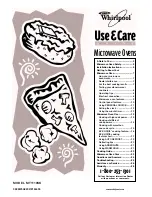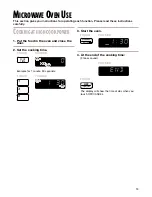
8
GETTING TO KNOW YOUR MICROWAVE OVEN
•
Steam buildup in whole eggs may cause them to
burst and damage the oven. Cover poached eggs
and allow a standing time.
•
Heated liquids can splash out during and after
heating. Use of a wooden stir stick placed in the cup
or bowl during heating may help to avoid this.
•
Microwaves may not reach the center of a roast. The
heat spreads to the center from the outer, cooked
areas just as in regular oven cooking. This is one of
the reasons for letting some foods (for example,
roasts or baked potatoes) stand for a while after
cooking, or for stirring some foods during the
cooking time.
•
Do not deep fry in the oven. Microwavable utensils
are not suitable and it is difficult to maintain
appropriate deep-frying temperatures.
•
Do not overcook potatoes. At the end of the
recommended cooking time, potatoes should be
slightly firm because they will continue cooking
during standing time. After microwaving, let
potatoes stand for 5 minutes. They will finish
cooking while standing.
E
LECTRICAL CONNECTION
If your electric power line or outlet voltage is less than
110 volts, cooking times may be longer. Have a
qualified electrician check your electrical system.
T
ESTING YOUR DINNERWARE
OR COOKWARE
Test dinnerware or cookware before using. To test a
dish for use, put it into the oven with 1 cup (250 mL)
of water beside it. Cook at 100% cook power for one
minute. If the dish gets hot and water stays cool, do
not use it. Some dishes (melamine, some ceramic
dinnerware, etc.) absorb microwave energy and may
become too hot to handle and slow cooking times.
Cooking in metal containers not designed for micro-
wave use could damage the oven, as could
containers with hidden metal (twist-ties, foil lining,
staples, metallic glaze or trim).
O
PERATING TIPS
•
Never lean on the door or allow a child to swing on
it when the door is open.
•
Use oven mitts or pot holders when removing
containers from oven.
•
Do not use newspaper or other printed paper in the
oven.
•
Do not dry flowers, fruit, herbs, wood, paper,
gourds, or clothes in the oven.
•
Do not start a microwave oven when it is empty.
Product life may be shortened. If you practice
programming the oven, put a container of water in
the oven. It is normal for the oven door to look wavy
after the oven has been running for a while.
•
Do not try to melt paraffin wax in the oven. Paraffin
wax will not melt in a microwave oven because it
allows microwaves to pass through it.
•
Do not operate the microwave oven unless the glass
turntable is securely in place and can rotate freely.
The turntable can rotate in either direction. Make
sure the turntable is correct-side up in the oven.
Handle your turntable with care when removing it
from the oven to avoid possibly breaking it. If your
turntable cracks or breaks, contact your dealer for a
replacement.
•
When you use a browning dish, the browning dish
bottom must be at least
3
⁄
16
in. (5 mm) above the
turntable. Follow the directions supplied with the
browning dish.









































